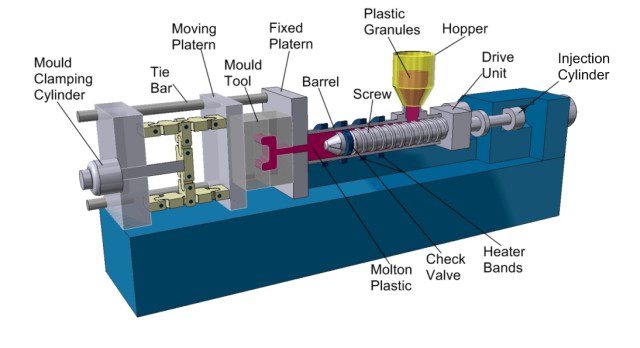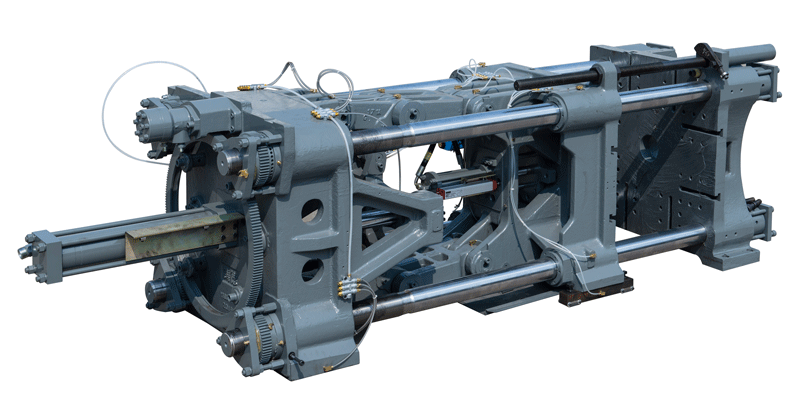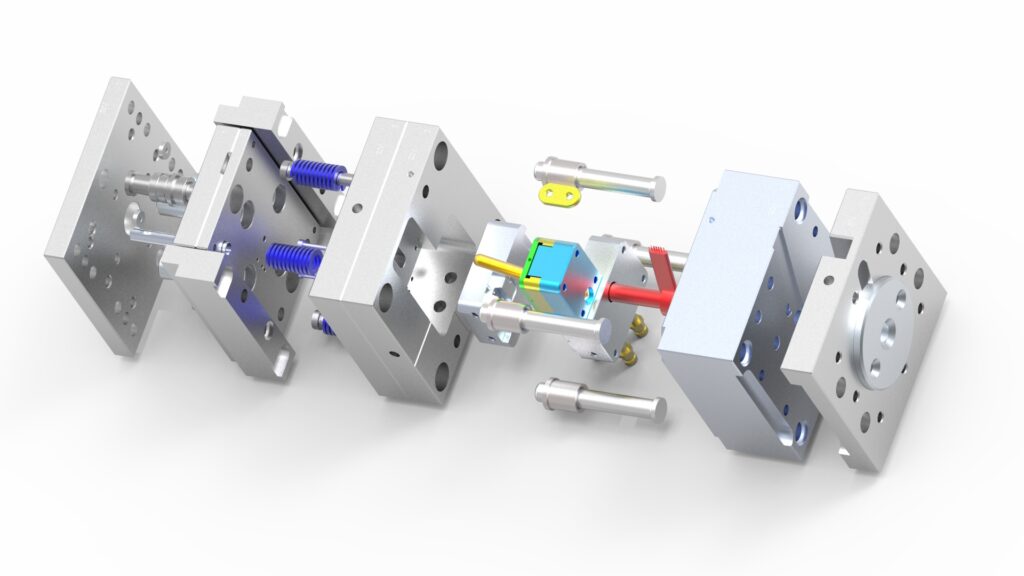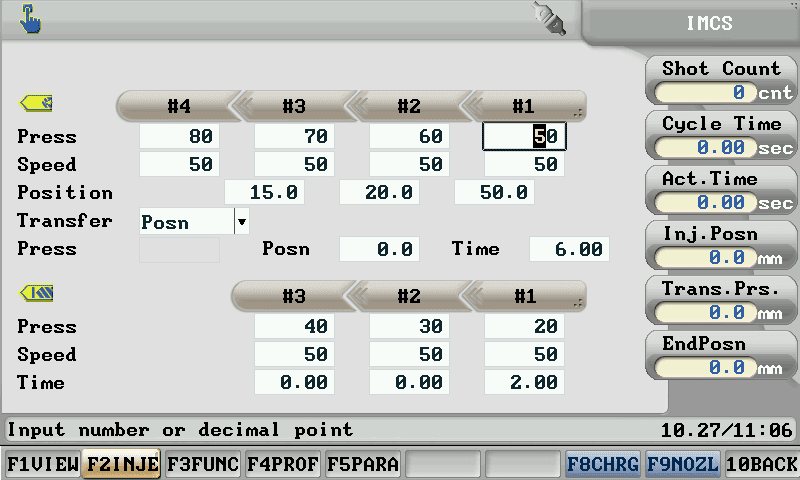What are the main technical features of a Plastic molding machine?
2023/12/08 By Topstar

Because of its leading technical features, the plastic molding machine can become the most critical link in producing plastic products. The composition of several vital parts, such as the injection device, clamping unit, mold, and control center, is their central core technology. We will introduce these main technical features to you in detail below.
Injection device of plastic molding machine
The injection device of a plastic molding machine is a crucial component responsible for the accurate and controlled delivery of molten plastic into the mold cavity. The injection device consists of several key features, such as a screw, barrel, and nozzle. They convert raw plastic materials into the required plastic. It plays a crucial role in shaping the required shape. As it rotates, the plastic resin is transported along the spiral path of the screw, going through melting and mixing stages. The barrel surrounding the screw maintains optimal temperature and pressure conditions to ensure consistent melt quality. The nozzle is located at the end of the barrel and serves as the inlet for pouring molten plastic into the mold. The accuracy of the injection unit is critical to controlling variables such as temperature, pressure, and speed that affect the quality and integrity of the final molded product.
Clamping unit of plastic molding machine
The mold clamping device in a plastic molding machine is essential for holding the mold firmly in place during the injection molding process. The device consists of a mold clamping mechanism, a mold, and a tie rod. It plays a crucial role in ensuring the accuracy, stability, and safety of the entire molding cycle of the plastic molding machine.
The clamping mechanism is usually hydraulic or mechanical and applies force to hold the two halves of the mold together during the injection process. The unit is designed to achieve consistent and accurate mold closing, preventing leakage or deformation of the final product. Tie rods are strong metal rods connecting the movable formwork to the fixed formwork, providing structural support to withstand the intense forces generated during molding.

Mold
First, the mold determines the external and internal characteristics of the final plastic product. Its intricately designed cavities and surfaces choose the product’s shape, size, and texture finish. The accuracy of the mold is directly related to the accuracy and consistency of the molded parts. An adequately designed mold ensures even filling of the cavity and minimizes defects such as voids or warpages. Effective cooling channels within the mold help the plastic solidify quickly and evenly, affecting cycle times and overall production efficiency.

The control center of the plastic molding machine
The control center of a plastic molding machine is a complex hub responsible for managing and coordinating the entire injection molding process. This critical component encompasses a range of technologies and functions, with the core being the operator control interface, a platform where operators monitor, control, and adjust various parameters. This includes temperature, pressure, injection speed, and cycle time settings. At the same time, the control center usually integrates PLC and CNC systems. These technologies enable automation, allowing precise and repeatable molding process control. Automated controls help reduce errors, enhance product consistency, and improve efficiency.

Ability to handle materials
The material handling capabilities in plastic molding machines cover all stages, from raw material preparation to feeding, melting, and injection into the mold. The process begins with carefully selecting and preparing plastic resin pellets, considering factors such as polymer type, color, and additives. Material handling units transport these pellets into the machine’s hopper in automated systems, ensuring a continuous and controlled supply. Efficient material handling enables cooling systems within the mold to aid solidification. Depending on the desired end product, post-molding material handling may involve additional processes such as trimming, assembly, or packaging.
Final summary
When we fully understand the main features of plastic molding machines, we can easily use them in the production process. A qualified plastic molding machine must be indispensable for this crucial part. Only with good maintenance and correct use can your plastic molding machine exert its maximum function.
TRENDING POSTS
- What factors can cause delays in the injection molding process of plastic molding machine? 2023/12/08
- Exhibition Review| Topstar participates in InterPlas Thailand 2024 2023/12/08
- Star Case | Topstar helps Santong upgrade its intelligent plant 2023/12/08
- Topstar Special | National Science and Technology Workers Day 2023/12/08
HOT TOPIC
- .ervo motor-driven linear robots
- 3 axis robot
- 3 axis robots
- 3 in 1 Compact Dehumidifying Dryer
- 3-axis robot
- 3-axis robots
- 5-axis CNC machine
- accuracy
- Air Chillers
- all electric injection molding machine
- all electric injection molding machines
- All-electric injection molding machines
- and overall production quality. Therefore
- AP-RubberPlas
- automated injection molding machine
- Automation changed engineering
- automation of injection molding robots
- auxiliary machine
- Bench Injection Molding Machine
- Cabinet dryer manufacturers
- Cabinet dryers
- chiller
- CNC Drilling Machine
- CNC Drilling Machines
- cnc engraving machine manufacturer
- cnc laser cutting machine manufacturer
- CNC machine
- CNC Machine Center
- CNC Machine for Sale
- CNC Machine Manufacturing
- CNC Machine Tool
- CNC machine tool product
- CNC Machining Center
- CNC wood carving machine
- Cooling system
- Cross-Walking Single Axis Servo Cylinder Robot
- Cross-Walking Single-Axis Servo Cylinder Robot
- Cross-Walking Three-Axis/Five-Axis Servo Driven Robot
- cross-walking three-axis/five-axis servo-driven robot
- Dehumidifier Dryer
- Dehumidifying Dryer
- delta parallel robot
- Desktop Injection Molding Machine
- Desktop injection molding machines
- Desktop Molding Machine
- desktop plastic injection machine
- Desktop Plastic Injection Molding Machine
- direct clamp injection molding machine
- Direct clamp injection molding machines
- Dosing & mixing system
- Drilling Centers
- Drying and dehumidification system
- drying and dehumidifying equipment
- Drying and Dehumidifying System
- drying system
- effective and efficient. Cabinet dryers are also used in other industries where large quantities of material need to be dried
- efficient injection molding machine
- elbow hydraulic injection molding machines
- electric injection molding machine
- electric injection molding machines
- energy-efficient injection molding robot
- energy-saving injection molding machine
- etc. Among injection molding robots
- exhibition
- features of CNC machine
- Feeding And Conveying System
- Five Axis Machine Center
- Fully automatic injection molding machine
- Gathering Topstar
- giant injection molding machine
- GMU-600 5-Axis Machining Center
- Granulating & Recycling System
- Heavy duty injection molding machine
- High-precision electric molding machines
- high-precision plastic molding machines
- high-speed all electric injection molding machine
- Honeycomb rotor dehumidifier
- horizontal injection molding machine
- Horizontal Injection Molding Machines
- Horizontal Injection Moulding Machine
- Horizontal Mixer manufacturer
- How The CNC Machine Works
- hybrid injection molding machine
- hydraulic injection molding machine
- Hydraulic Injection Molding Machines
- in this article
- Industrial robot
- Industrial Robot Chinese brand
- industrial robot parts
- industrial robot supplier
- Industrial robots
- Industry Chain
- Injection Manipulator
- injection manipulator robot
- injection mold machines
- Injection molding
- Injection molding automation
- Injection Molding Automation Solution
- injection molding dryer
- Injection molding equipment
- injection molding hopper dryer
- Injection molding machine
- injection molding machine brand
- Injection Molding Machine Factory
- Injection Molding Machine Manufacture
- Injection molding machine manufacturer
- injection molding machine manufacturers
- Injection molding machine procurement
- injection molding machine robotic arm
- injection molding machine with a robot
- Injection molding machines
- injection molding material dehumidifying
- injection molding plant
- Injection Molding Robot
- injection molding robot arm
- Injection molding robot automation
- Injection molding robotic arm
- injection molding robots
- Injection moulding machine
- Injection Moulding Robots
- Injection Robot
- Injection robot arm
- Injection robot manufacturer
- Injection robot wholesale
- injection robots
- intelligent injection molding machines
- Introducing Injection Robot
- It is the best choice for drying large quantities of material at once. Cabinetmakers use these machines because they are fast
- large injection molding machine
- large injection molding machines
- Learn what industrial automation and robotics is
- linear robot
- linear robots
- low speed sound-proof granulator
- machine plastic molding
- make sure to add some! Improvements (2) Keyphrase in introduction: Your keyphrase or its synonyms appear in the first paragraph of the copy
- manipulator machine
- manufacturing
- medical grade injection molding machines
- medical injection molding machine
- medical injection molding machines
- micro injection molding machine
- middle speed granulator
- Mini CNC machine manufacturers.
- Mold Temperature Control System
- mold temperature controller
- mold temperature controllers
- molding material Dehumidifying System
- mould temperature control system
- mould temperature controller
- mould temperature controllers
- New electric injection molding machine
- nitrogen dryer manufacturer
- nitrogen dryer system manufacturer
- Oil type mold temperature controller
- Oil type mold temperature controllers
- open day
- Outbound links: No outbound links appear in this page. Add some! Images: No images appear on this page. Add some! Internal links: No internal links appear in this page
- PET Preform injection molding
- phone case maker machine
- phone case making machine
- plastic bottle making machine
- plastic bottle manufacturing
- plastic bucket making machine
- plastic bucket manufacturing
- Plastic chair making machine
- plastic forming equipment
- plastic hopper dryer
- plastic injection machine
- plastic injection machines
- plastic injection molding
- Plastic injection molding equipment
- Plastic injection molding machine
- Plastic Injection Molding Machines
- plastic injection moulding machine
- plastic injection robot
- Plastic Molding machine
- Plastic Molding Machines
- plastic molding press
- plastic moulding machine
- plastic phone case making machine
- plastic-molding machine
- powerful granulator
- Powerful Type Sound-Proof Granulator
- precision injection molding
- precision injection molding machines
- production of plastic seats
- pure water mould temperature controller
- Robot injection molding
- robot injection molding machine
- robot manufacturing companies
- Robotic arm for injection molding machine
- robotic injection molding machines
- robotics in injection molding
- SCARA robot
- SCARA robots
- Service-oriented manufacturing
- Servo Cylinder Robot
- servo driven robot
- Servo Driven Robots
- servo injection robots
- servo motor-driven linear robots
- servo-driven 3-axis robot
- Servo-Driven Robot
- Setup of injection machine
- Silicone Injection Molding Machine
- six-axis industrial robot
- Stainless Hopper Dryer
- Stainless Hopper Dryers
- star club
- swing arm robot
- take-out robots
- the choice between servo-driven robots and hydraulic robots will have a certain impact on efficiency
- the most popular injection molding machine
- the type of injection molding robot
- toggle clamp injection molding machine
- Toggle Hydraulic Injection Molding Machines
- toggle injection molding machine
- Top 10 brands of injection robots
- Topstar
- Topstar Engineering
- Topstar Industrial Robots
- Topstar injection molding intelligent
- Topstar Scara Robots
- Useful Injection molding machine
- Vertical machining centers
- volumetric type blender
- water chiller
- water chillers
- water distributor
- water type mold temperature controller
- Water Type MoldTemperature Controller
- Water-Type Mould Temperature Controllers
- We often face choices when performing injection molding. We will choose the type of injection molding machine
- wholesale of injection molding machines
- x carve CNC
